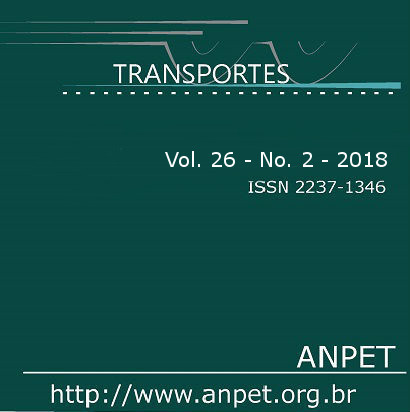Estratégia de utilização da folga de tração de trens para planejamento da distribuição de vagões vazios
DOI:
https://doi.org/10.14295/transportes.v26i2.1537Keywords:
Distribution of empty wagons, Railway transport, Railway transport.Abstract
Planning the distribution of empty wagons in rail transport is important because most wagons on Brazilian railways return empty from the unloading rail yard to the loading rail yard without bringing any revenue for the railway and adding costs due to engine driver and diesel. Therefore, this article proposes an Integer Programming mathematical model based on a strategy for the distribution of empty wagons, where they are distributed using the non-used traction capacity of the trains which will travel with loaded wagons. To evaluate the proposed model, instances were created based on real data from Central Atlantic Railroad (FCA). They were optimally solved using CPLEX 12.6 solver. The mathematical model using the proposed strategy presented reduction in making up trains only with empty wagons compared to the manual planning of the railway.
Downloads
References
Bektaş, T; T. G. Crainic e V. Morency. Improving the performance of rail yards through dynamic reassignments of empty cars. Transportation Research Part C: Emerging Technologies, v. 17, n. 3, p. 259-273, 2009. Disponível em: https://doi.org/10.1016/j.trc.2008.11.003
CNT - Confederação Nacional do Transporte (2017) Anuário CNT do Transporte. Brasília: CNT
Cordeau, J. F.; P. Toth e D. Vigo (1998) A survey of optimization models for train routing and scheduling. Transportation Scien-ce, v. 32, n. 4, p. 380-404. Disponível em: https://doi.org/10.1287/trsc.32.4.380
Costa, J. C. (2010) Algoritmo de Distribuição e Alocação Vagões em Tempo Real. Dissertação de Mestrado, UNICAMP, 2010.
Crainic, T. G.; G. Laporte (1997) Planning models for freight transportation. European Journal of Operational Research, v. 97, n. 3, p. 409-438.
Disponível em: https://doi.org/10.1016/S0377-2217(96)00298-6
Dejax, P. J.; T. G. Crainic (1987) Survey paper—a review of empty flows and fleet management models in freight transporta-tion. Transportation Science, v. 21, n. 4, p. 227-248, Disponível em: https://doi.org/10.1287/trsc.21.4.227
Fukasawa, R. (2002) Resolução de problemas de logística ferroviária utilizando programação inteira. Dissertação (Mestrado em Engenharia Elétrica). Programa de Pós-Graduação em Engenharia Elétrica, Pontifícia Universidade Católica do Rio de Janeiro - PUC-RJ.
Haghani, A. E. (1989) Formulation and solution of a combined train routing and makeup, and empty car distribution model. Transportation Research Part B: Methodological, v. 23, n. 6, p. 433-452. Disponível em: https://doi.org/10.1016/0191-2615(89)90043-X
Holmberg, K.; M. Joborn e J. T. Lundgren (1998) Improved empty freight car distribution. Transportation Science, v. 32, n. 2, p. 163-173. Disponível em: https://doi.org/10.1287/trsc.32.2.163
IBM. CPLEX Optimization Studio. Disponível em: https://www.ibm.com/br-pt/ (Acesso em: 6 abr. 2017)
Joborn, M. et al. (2004) Economies of scale in empty freight car distribution in scheduled railways. Transportation Science, v. 38, n. 2, p. 121-134. Disponível em: https://doi.org/10.1287/trsc.1030.0061
Melo, M. C. V.; J. F. Barros Neto e E. F. Nobre Jr. (2008) Problema de Planejamento da Alocação de Vagões de Carga: uma Aborda-gem via Modelagem Matemática. Transporte em Transformação XIII.
Misra, S. C.(1972) Linear programming of empty wagon disposition. Rail International, v. 3, n. 3.
Philip, C.E. (1978) Freight car utilization and railroad reliability: the application of an inventory model to the railroad empty car distribution process. Technical Report MIT MIT-CTS-78-2, Center for Transportation Studies, Cambridge, MA.
Powell, W. B.; B. Bouzaiene-Ayari e H. P. Simao (2007) Dynamic models for freight transportation. Handbooks in operations research and management science, v. 14, p. 285-365.
Powell, W. B.; T. A. Carvalho (1998) Real-time optimization of containers and flatcars for intermodal opera-tions. Transportation Science, v. 32, n. 2, p. 110-126, Disponível em: https://doi.org/10.1287/trsc.32.2.110
Powell, W. B. e H. Topaloglu (2005) Fleet management. In: Wallace, S., Ziemba, W. (Eds.), Applications of Stochastic Program-ming Math Programming Society-Series on Optimization. SIAM, Philadelphia.
Sherali, H. D. e A. B. Suharko (1998) A tactical decision support system for empty railcar management. Transportation Science, v. 32, n. 4, p. 306-329, Disponível em: https://doi.org/10.1287/trsc.32.4.306
Spieckermann, S.; S. VOß (1995) A case study in empty railcar distribution. European Journal of Operational Research, v. 87, n. 3, p. 586-598. Disponível em: https://doi.org/10.1016/0377-2217(95)00232-4
White, W. W.; A. M. Bomberault (1969) A network algorithm for empty freight car allocation. IBM Systems Journal, v. 8, n. 2, p. 147-169.
Downloads
Published
How to Cite
Issue
Section
License
Authors who submit papers for publication by TRANSPORTES agree to the following terms:
- The authors retain the copyright and grant Transportes the right of first publication of the manuscript, without any financial charge, and waive any other remuneration for its publication by ANPET.
- Upon publication by Transportes, the manuscript is automatically licensed under the Creative Commons License CC BY 4.0 license. This license permits the work to be shared with proper attribution to the authors and its original publication in this journal.
- Authors are authorized to enter into additional separate contracts for the non-exclusive distribution of the version of the manuscript published in this journal (e.g., publishing in an institutional repository or as a book chapter), with recognition of the initial publication in this journal, provided that such a contract does not imply an endorsement of the content of the manuscript or the new medium by ANPET.
- Authors are permitted and encouraged to publish and distribute their work online (e.g., in institutional repositories or on their personal websites) after the editorial process is complete. As Transportes provides open access to all published issues, authors are encouraged to use links to the DOI of their article in these cases.
- Authors guarantee that they have obtained the necessary authorization from their employers for the transfer of rights under this agreement, if these employers hold any copyright over the manuscript. Additionally, authors assume all responsibility for any copyright infringements by these employers, releasing ANPET and Transportes from any responsibility in this regard.
- Authors assume full responsibility for the content of the manuscript, including the necessary and appropriate authorizations for the disclosure of collected data and obtained results, releasing ANPET and Transportes from any responsibility in this regard.










